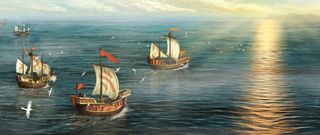Anno Online preview: first look at the free-to-play city-builder

Of the three titles I saw at Blue Byte's headquarters in Dusseldorf, Anno Online was the least surprising. Both because the F2P online genre is saturated with city-building games, from Evony to Lords of Ultima to The Nile Online, and because one of Blue Byte's own The Settlers Online was successful enough that the company has grown from just 50 employees to over 300. Don't be mistaken. Just because it's predictable, that doesn't mean it won't be interesting.
I was shown around the world of Anno Online by the game designer Tom Boulton. As he explained to me, Anno Online is a simple city-building title. A player's aim is just to build the most grandiose city they can, stringing together all the resource chains and Venn diagrams of desires and supplies to ensure that all their citizens get just what they need. With 120 building types and more than 800 buildings in each city, there's a lot of maths to be done.

Looking down at the first city, I can see a grandiose cathedral being built at the centre of a prosperous town centre. As my eye travels out from the cathedral, I see the buildings shrink from the estates of the grand nobles, to the red-roofed blocks of the patrician class, to the small houses of the slogging citizens and then, on the outskirts, the field-scattered hovels of the peasants. Happy areas have celebrating citizens in the streets; unhappy areas have rioting peasants. It's a classic Anno 1404 scene, but more iconic, and in Flash.

Back to that cathedral. To build the largest structures, players must band together and co-operate to complete quests like this. Boulton explained that there is a guild system, global chat, online leaderboards, stat tracking, and a mail system in place – as well as an avatar creation tool with 3.5 million combinations. Players can visit each other's islands, though it's not clear what they'd do if they did. Though Boulton didn't show me exactly how they'd build the cathedral, he did imply that these major projects would take several realtime days to complete.

To get anywhere near that size of city, players need to start from scratch. Each player has access to nine island slots; the first five of these unlock as you play the game, the remaining four are microtransaction-purchased only. The starting island has a fixed layout, though the resources are placed pseudo-randomly. Once you've colonised that and got to a high enough development level, you'll be able to build ships and send them out to colonise your other islands. As each island has access to a different resource, players will need to occupy each island to balance their economy – or specialise further and trade with friends.

Of course, the big question is always how Ubisoft is going to make its money from the game, without breaking it. Here, paying players can buy progress acceleration, as there's a certain amount of built-in waiting for expansion and exploration in the game. That's a dangerous move, as it encourages designing every action to take forever. However, the vast majority of the items they can buy are purely cosmetic.
Like the other two games I saw at Blue Byte's Dusseldorf headquarters - Silent Hunter Online and Heroes of Might & Magic Online - this is more of an iteration from the existing game than a radical departure.
PC Gamer Newsletter
Sign up to get the best content of the week, and great gaming deals, as picked by the editors.
Most Popular




